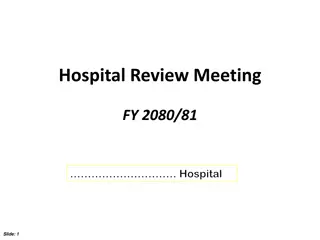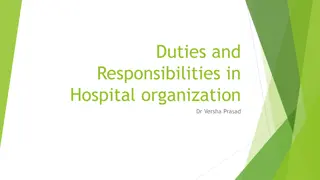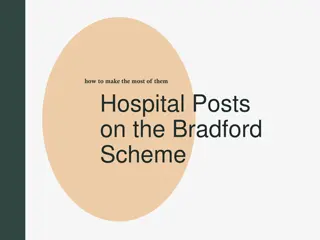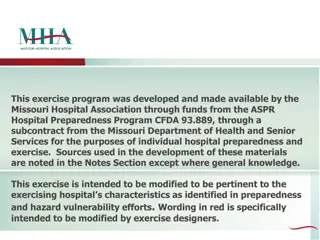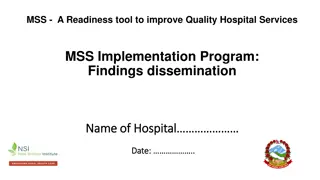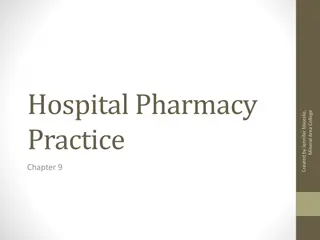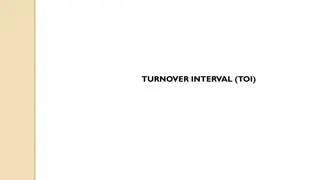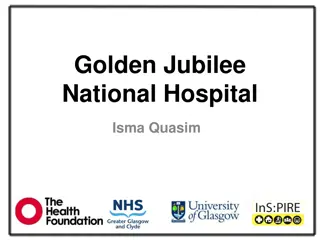Understanding Hospital Classification and Organization Structure
Hospitals play a crucial role in providing healthcare services. This content delves into the definition of hospitals, classification based on therapy, ownership, system of medicine, and medical staff. It also explores the organization structure and services offered by hospitals, aiding learners in gaining a comprehensive understanding of hospital operations.
Download Presentation

Please find below an Image/Link to download the presentation.
The content on the website is provided AS IS for your information and personal use only. It may not be sold, licensed, or shared on other websites without obtaining consent from the author. Download presentation by click this link. If you encounter any issues during the download, it is possible that the publisher has removed the file from their server.
E N D
Presentation Transcript
D. Pharm II year Subject code: DP- 206, Hospital and clinical Pharmacy Hospital and it s Organisation (Dr.) Anupriya Kapoor Assistant Professor School of Pharmaceutical Sciences, CSJMU , Kanpur 1
Learning objective 1. What is Hospital? 2. How to classify hospitals? 3. What could be the organisation structure of Hospital? 4. What are the functions and services offered by Hospital? 2
Outcomes After going through these slides, the learner would be able to understand following points 1. Definition of Hospital 2. Classification of Hospital on various basis 3. Organisation structure of Hospital 4. Services provided by Hospital 3
Hospital Hospital: It is a health care organisation that has a team of well qualified trained staff and all technical equipments that are required for the treatment of specific disease in patient. 4
Hospital can be called aCity inside a city that has all required facilities like building, equipments, team of qualified personals, fooding, laundry, transportation communication facility, electric and water supply etc. That work in collaboration for treatment of patient. facility, 5
Classification of Hospitals Hospitals can be classified on various basis 1. Clinical basis: on basis of therapy provided by Hospital a. Maternity Hospitals b. Surgical Hospitals c. Medicinal Hospitals 6
2. On basis of ownership a. Government Hospitals I. Public health services (AIIMS, PGI) II. Military Hospitals b. Non government Hospitals I. Private Hospitals II. Charitable Hospitals 7
3. On the basis of system of medicine a. Allopathic Hospitals b. Ayurvedic Hospitals c. Homeopathic Hospitals d. Unani Hospitals e. Rehabilitation centres 4. On basis of medical staff a. Closed staff b. Open staff 8
5. On basis of number of beds a. Small Hospitals ( beds up to 100 ) b. Medium Hospitals ( beds 101 to 499 ) c. Large Hospitals ( beds above 500 ) 6. On basis of teaching activities a. Teaching Hospitals b. Non teaching Hospitals 7. As per WHO a. Regional Hospitals b. District Hospitals c. Rural Hospitals 9
8. On basis of cost a. Elite Hospitals b. Low budget Hospitals 9. On basis of level of Health care a. Primary b. Secondary c. Tertiary 10
Functions of Hospital Functions of hospital can be bifurcated in two manners 1. Primary function (Curative function) 2. Secondary function ( Preventive, Research, Training) 11
Curative function It is the basic function of the hospital and is associated with providing care to patient. It depicts any type of care that is provided to the patients by health care providers e.g. physicians, nurses, dieticians. Also includes health education to patients 12
Preventive function It is popping up function of the hospital and concerned with health promotion It is concerned with providing the preventive services through a community health centre It has an active role to improve the health of the population 13
Research function It is a secondary function of hospital and is concerned with managing the health related researches that emphasis on the betterment of the health and/or prevention of diseases. 14
Training function It is a secondary function and is connected with providing training and educational courses for the professional and technical personnel who provides health services (e.g. physicians, nurses, dentists, therapist) 15
Organisation structure of Hospital Board Administration Informative services Supportive services Therapeutic services Diagnostic services Admission Central supply, Biomedical ,Housekeeping, transportation, gardening etc. PT/ OT, Speech and Language therapy, Pharmacy, Nursing, Sports medicine, Dietary Billing Med. Lab, Radiology, CT, MRI , X ray etc. Medical record documentation, Health education, Human resource etc 16
Importance of Organisation structure Facilitates the understanding of the hospital s chain. The complexity of organizational structure depends on size of healthcare facility. hospitals with big acute facilities have complicated structures, on contrary the smaller institutions have a basic organizational structure. Each hospital department functions, departments are generally grouped according to analogy of duties in order to promote efficiency of the healthcare facility. performs specific 17
Organisation categories of Hospital Hospital organisation categories Administration Services Information Services Diagnostic Services Therapeutic Services Support Services 18
Roles of Hospital Administration To supervise the the operation of departments To control budgeting and finance To design hospital policies and procedures. To perform public relation duties Members of administration include: Hospital President, Vice Presidents, Assistants, Department Heads Executive 19
Roles of Information services 1. Admissions personnel-are usually the public s first contact with in the hospital,check patients into hospital demographics of each patient 2. They assign patients their hospital room and their hospital identification number and obtain 20
2. Billing and Collection- concerned with billing patients for services used by them 3. Health Information Management - maintains copies of all patient records 4. Information Services-associated computers and hospital network 5. Health Education-responsible for staff and patient health-related education 6. Human Resources-responsible for recruiting employees and making policies for their benifits with 21
Roles of Therapeutic services Provides treatment to patients Physical therapy Occupational therapy Speech/ language therapy Pathology Medical Psychology Respiratory Therapy (RT) Pharmacy Dietary Sports Medicine Nursing 22
Roles of Diagnostic services To determine the cause(s) of illness or injury It has different departments like a. Medical Laboratory (MT) it is concerned with studies related to body tissues, to determine abnormalities b. Imaging studies- images of body parts to determine lesions and abnormalities. Includes Diagnostic Radiology, MRI, CT, Ultra Sound. c. Emergency Medicine to provide emergency diagnoses and treatment 23
Roles of Supportive services Provides support to entire hospital. 1. Central Supply-has responsibility of ordering, receiving, stocking and distributing all equipment and supplies used by healthcare facility, sterilizes instruments and supplies, cleans and maintains hospital linen and patient gowns. 2.Biomedical Technology-designs biomedical equipment (engineers) by diagnosing and repairing defective equipment (biomedical technicians) and also provides preventative maintenance to all hospital equipment. and build 24
3. Housekeeping department is responsible to maintain a safe clean environment by cleaners, electricians, carpenters, and gardeners. and Maintenance- the 25
References 1. Dr Ramesh k Goyal et al a Text Book of Hospital Pharmacy, B.S. Shah Prakashan. 2. Dr. Ramesh K. Goyal; Dr. R.K.Parikh, Dr. Mayur M. Patel; Merchant & Goyal s; A Textbook of Hospital Pharmacy; Edition- 13th. 3. http://www.srmuniv.ac.in/sites/default/files/files/H ospital.pdf 26
THANKYOU 27


